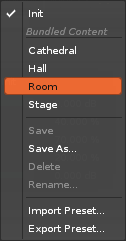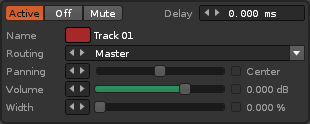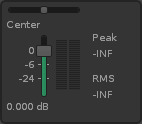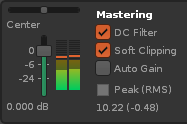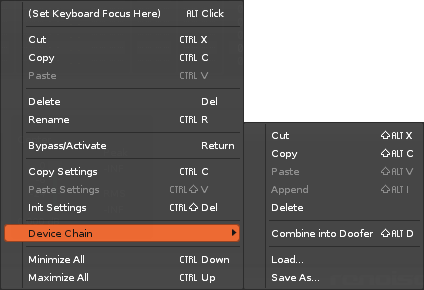Effect Chains: Difference between revisions
imported>Achenar No edit summary |
mNo edit summary |
||
| (28 intermediate revisions by 2 users not shown) | |||
| Line 1: | Line 1: | ||
= Effect Chains = | = Effect Chains = | ||
Effects can be applied in two ways: [[Effects|directly onto samples]], affecting only those sounds, or ''(Renoise only)'' inserted into [[Pattern Editor# | Effects can be applied in two ways: [[Effects|directly onto samples]], affecting only those sounds, or ''(Renoise only)'' inserted into [[Pattern Editor#Track Types|tracks]], affecting all sounds that are played there. Either way, devices are inserted into an interactive effect chain, with the audio signal running through each device from left to right. The devices can be chosen from the pool of native effects or ''(Renoise only)'' any [[Plugin Effects|third-party plugin]]. | ||
The native devices come in four different categories. [[Audio Effects]] alter the sound in a variety of ways. [[Meta Devices]] do not change the actual audio signal themselves, but instead alter the parameters of another effect. [[Routing Devices]] either send audio to another FX Chain/track or receive a signal from an external source. [[Doofers]] are special devices that contain their own effect chain within them and provide easy access to their most useful parameters through macros. | The native devices come in four different categories. [[Audio Effects]] alter the sound in a variety of ways. [[Meta Devices]] do not change the actual audio signal themselves, but instead alter the parameters of another effect. [[Routing Devices]] either send audio to another FX Chain/track or receive a signal from an external source. [[Doofer,_Splitter_%26_Notepad|Doofers and Splitters]] are special devices that contain their own effect chain within them and provide easy access to their most useful parameters through macros. | ||
A song or instrument created using only these native effects can be saved and given to other people, where it will play back on their copy of Renoise/Redux exactly as it did on yours. '' | A song or instrument created using only these native effects can be saved and given to other people, where it will play back on their copy of Renoise/Redux exactly as it did on yours. ''Renoise only: However, if [[Plugin Effects|plugin effects]] or [[Plugin|plugin instruments]] (VST, AU, LADSPA, DSSI) are used, these external programs must also be installed on their system, otherwise they won't be played.'' | ||
[[Image:3. | [[Image:3.5_trackeffects.png]] | ||
== The Effects List == | == The Effects List == | ||
If you're adding effects to | If you're adding effects to samples: In Renoise make sure you're in the [[Effects|Sampler -> Effects]] section. In Redux, just click on the Effects tab. | ||
If you're adding effects to | If you're adding effects to a track in Renoise, use the effect list in the [[Pattern Editor]] by selecting its icon at the lower left corner of the interface: [[Image:3.2_lowerstatusbar-trackeffects.png|text-bottom]] | ||
Either way, the list of available effects is found at the bottom left and is categorised like so: | Note that when the [[Mixer]] has been detached as a separate window the entire Track Effects panel and its button are moved with it. | ||
Either way, the list of available effects is found at the bottom-left and is categorised like so: | |||
* Native | * Native | ||
** [[Audio Effects]] | ** [[Audio Effects]] | ||
** [[Meta Devices]] | |||
** [[Routing Devices]] | ** [[Routing Devices]] | ||
** [[ | ** [[Doofer,_Splitter_%26_Notepad|Utilities]] | ||
** [[Doofers]] | ** [[Doofer,_Splitter_%26_Notepad|Doofers]] | ||
* ''(Renoise only)'' | ** [[Doofer,_Splitter_%26_Notepad|Splitters]] | ||
** Plugin | * ''(Renoise only)'' VST/VST3/AU/LADSPA/DSSI - ''note that VST & VST3 plugins are split into separate categories'' | ||
** [[Plugin Effects]] | |||
You can quickly search for an effect by typing part of its name in the search bar at the top of the list. This also works for categories, so typing in "VST" will show only VST plugins in the list. | You can quickly search for an effect by typing part of its name in the search bar at the top of the list. This also works for categories, so typing in "VST" will show only VST plugins in the list. To add a device from the list to the effect chain, either double-click on it or drag and drop it into the chain at the desired position. | ||
'''Renoise only''' - You can also drag and drop an effect into any track while using the [[Mixer]]: | |||
[[Image:3. | [[Image:3.5_effects-trackfxmixer.png]] | ||
'''Renoise only''' - Note that although plugin effects and [[Plugin|plugin instruments]] may have the same format name i.e. VST, they are still fundamentally different. | '''Renoise only''' - Note that although [[Plugin Effects|plugin effects]] and [[Plugin|plugin instruments]] may have the same format name i.e. VST, they are still fundamentally different. Plugin effects will show up in the effects list shown here, while plugin instruments are handled in the [[Plugin]] section of the Instrument Editor. | ||
=== Organizing the List === | === Organizing the List === | ||
| Line 42: | Line 46: | ||
* '''Add To Favorites:''' Adds the selected plugin or vendor to your [[#Favorites List|favorites list]]. | * '''Add To Favorites:''' Adds the selected plugin or vendor to your [[#Favorites List|favorites list]]. | ||
* '''Add To Group:''' ''(Renoise only)'' Opens a new dialog box where you enter a name for the group. If it is a new name, then the group will created and the selected plugin(s) moved under it. If the group already exists, then the plugin(s) will be moved over to the group. | * '''Add To Group:''' ''(Renoise only)'' Opens a new dialog box where you enter a name for the group. If it is a new name, then the group will be created and the selected plugin(s) moved under it. If the group already exists, then the plugin(s) will be moved over to the group. | ||
* '''Ungroup:''' ''(Renoise only)'' ''(Only available when clicking on an existing group or vendor name)'' Removes the selected group from the effects list. | * '''Ungroup:''' ''(Renoise only)'' ''(Only available when clicking on an existing group or vendor name)'' Removes the selected group from the effects list. | ||
| Line 48: | Line 52: | ||
* '''Hide:''' Excludes a plugin or a category of plugins from the list. This can be useful if you no longer use a plugin, but don't want to uninstall it because old songs still use it. To make a hidden plugin visible again, enable the ''"Show Hidden Devices"'' option, then simply ''"Unhide"'' it again. | * '''Hide:''' Excludes a plugin or a category of plugins from the list. This can be useful if you no longer use a plugin, but don't want to uninstall it because old songs still use it. To make a hidden plugin visible again, enable the ''"Show Hidden Devices"'' option, then simply ''"Unhide"'' it again. | ||
* '''Collapse Whole Tree:''' Collapses the entire effects list, showing only the Favorites (if any exist), Native and VST categories. Handy if you need to show just a few effects. | * '''Collapse Whole Tree:''' Collapses the entire effects list, showing only the Favorites (if any exist), Native and VST/AU/LADSPA/DSSI categories. Handy if you need to show just a few effects. | ||
* '''Expand Whole Tree:''' The effects list will expand back to its full size again. | * '''Expand Whole Tree:''' The effects list will expand back to its full size again. | ||
| Line 61: | Line 65: | ||
[[Image:3.0_effects-favorites.gif]] | [[Image:3.0_effects-favorites.gif]] | ||
<!-- RENOISE_NO_PDF_STOP --> | <!-- RENOISE_NO_PDF_STOP --> | ||
== Common Device Layout and Controls == | == Common Device Layout and Controls == | ||
| Line 67: | Line 70: | ||
Each effect device has a standard set of buttons to perform common functions: | Each effect device has a standard set of buttons to perform common functions: | ||
* [[Image:3. | * [[Image:3.5_device-remove.png|text-bottom]] - Remove the device from the chain. | ||
* [[Image:3. | * [[Image:3.5_device-minmax.png|text-bottom]] - Minimize/maximize the device. | ||
* [[Image:3. | * [[Image:3.5_device-move.png|text-bottom]] - Move the device to the left or right. Right-click to move to the start or end of the chain. | ||
* [[Image:3. | * [[Image:3.5_device-enable.png|text-bottom]] - Enable/disable the device. | ||
* [[Image:3.5_device-rename.png|text-bottom]] - Double click on the device name to rename it. | |||
== Storing/Recalling Effect Presets == | == Storing/Recalling Effect Presets == | ||
* [[Image:3. | * [[Image:3.5_device-ab.png]] - Right-clicking on the A or B button will store the current set of parameter values. If the parameters are then changed to something else, left-clicking will restore them back to the stored values. Storing to both A and B allows you to quickly switch between two different presets and compare them. Any presets stored like this are saved with your song, so you don't need to worry about losing them. | ||
* [[Image:3. | * [[Image:3.5_device-preset.png]] - Select, edit or create presets for this effect. Clicking the preset name shows a list of available presets, along with some options: | ||
[[Image:3. | [[Image:3.5_device-presetmenu.png]] | ||
By | By choosing ‘Save As...’ from the menu and entering a name, the current parameters will be saved as a new preset in the [[Libraries|User Library]]. The presets will show up every time you use the effect device in future across both Renoise & Redux because they’re compatible and share their data from this same User Library. | ||
To save/load parameter presets to/from disk, use the ''"Import"'' and ''"Export"'' options in the same context menu. This method allows you to share your presets with other users. | To save/load parameter presets to/from disk, use the ''"Import"'' and ''"Export"'' options in the same context menu. This method allows you to share your presets with other users. | ||
Finally, when they’ve been selected from the menu, user created presets can also be renamed and deleted. We have an [https://youtu.be/EOe4AkkGNcQ Effect Presets video] showing all of this in action. | |||
== Pre and Post Mixer Effects == | == Pre and Post Mixer Effects == | ||
Two devices are always present in every effect chain and cannot be removed or repositioned: the Pre and Post Mixer devices. | Two devices are always present in every effect chain and cannot be removed or repositioned: the Pre and Post-Mixer devices. | ||
[[Image:3.5_device-premixer.png]] | |||
The Pre-Mixer device is located at the beginning of each effect chain and controls the routing, volume, panning of the incoming signal, and in Renoise it also controls the width and delay. | |||
'''Renoise only''' - In the [[Pattern Editor]]'s [[Pattern Editor#Tracks|standard Tracks]], this is normally the audio from the notes in that track, though [[Sampler_Effects#Output_Routing|Output Routing]] can change this. For [[Pattern Editor#Group Tracks|Groups]], [[Pattern Editor#Send Tracks|Sends]] and the [[Pattern Editor#Master Track|Master Track]], this is the audio that is being routed to them. | |||
[[Image:3. | [[Image:3.5_device-postmixer.png]] | ||
The Post-Mixer is located at the end of the effect chain | The Post-Mixer is located at the end of the effect chain, providing final control over the volume and panning of the audio leaving the track. The meter displays the current volume level, as well as indicating Peak and RMS. The highest Peak and RMS values are shown at the right. They will be reset when a song is played, and can also be manually reset by clicking on them. | ||
'''Renoise only''' - The Post- | '''Renoise only''' - The Post-Mixer device in the [[Pattern Editor#Master Track|Master Track]] has a few extra options to help manage the master signal: | ||
[[Image:3. | [[Image:3.5_device-postmixermaster.png]] | ||
* '''Auto Gain:''' | * '''DC Filter:''' When enabled, any DC offset in the master signal will be automatically removed. | ||
* ''' | * '''Soft Clipping:''' When enabled, the master signal will be softly saturated when clipping occurs. | ||
* '''Auto Gain:''' Automatically lowers the master volume when clipping occurs. This is the same as the [[Main Screen#Upper Status Bar|Upper Status Bar]]'s auto gain button: [[Image:3.2_upperstatusbar-autogain.png]] | |||
* '''Peak (RMS):''' Shows the master volume level as two values, Peak and RMS. Using this you can easily see if the master signal is clipping and by how much. The values will be reset when a song is played, and can also be manually reset by clicking on them. | |||
== Copy/Pasting Effect Chains == | == Copy/Pasting Effect Chains == | ||
Right clicking on a device or into the free space between the effects will show a context menu with various options for the whole chain, or the currently selected chain. This way you can delete, cut, copy or paste whole chains, or | Right clicking on a device or into the free space between the effects will show a context menu with various options for the whole chain, or the currently selected chain. This way you can delete, cut, copy or paste whole chains, or min/maximize all effects in the current chain. Please have a look at the following screenshot for all available options: | ||
[[Image:3. | [[Image:3.5_device-contextmenu.png]] | ||
== Loading/Saving Effect Chains == | == Loading/Saving Effect Chains == | ||
It is possible to export effect chains to disk for later use through the ''"Other"'' category in the [[Disk Browser]]. | It is possible to export effect chains to disk for later use through the ''"Other"'' category in the [[Disk Browser]]. Beware when loading an effect chain though, that the existing chain will be replaced with the new one. You can avoid this by right-clicking the chain file in the Disk Browser and then selecting, ''"Load file with options..."''. | ||
== MIDI Mapping and Automating Effects == | == MIDI Mapping and Automating Effects ''(Renoise Only)'' == | ||
The [[MIDI Mapping]] feature can be used to bind an effect parameter to a hardware MIDI controller, which is incredibly useful for recording and playing live. The parameters can also be automated using either [[Graphical Automation]] or [[Effect Commands]]. | |||
Latest revision as of 22:00, 1 December 2025
Effect Chains
Effects can be applied in two ways: directly onto samples, affecting only those sounds, or (Renoise only) inserted into tracks, affecting all sounds that are played there. Either way, devices are inserted into an interactive effect chain, with the audio signal running through each device from left to right. The devices can be chosen from the pool of native effects or (Renoise only) any third-party plugin.
The native devices come in four different categories. Audio Effects alter the sound in a variety of ways. Meta Devices do not change the actual audio signal themselves, but instead alter the parameters of another effect. Routing Devices either send audio to another FX Chain/track or receive a signal from an external source. Doofers and Splitters are special devices that contain their own effect chain within them and provide easy access to their most useful parameters through macros.
A song or instrument created using only these native effects can be saved and given to other people, where it will play back on their copy of Renoise/Redux exactly as it did on yours. Renoise only: However, if plugin effects or plugin instruments (VST, AU, LADSPA, DSSI) are used, these external programs must also be installed on their system, otherwise they won't be played.
The Effects List
If you're adding effects to samples: In Renoise make sure you're in the Sampler -> Effects section. In Redux, just click on the Effects tab.
If you're adding effects to a track in Renoise, use the effect list in the Pattern Editor by selecting its icon at the lower left corner of the interface: ![]()
Note that when the Mixer has been detached as a separate window the entire Track Effects panel and its button are moved with it.
Either way, the list of available effects is found at the bottom-left and is categorised like so:
- Native
- (Renoise only) VST/VST3/AU/LADSPA/DSSI - note that VST & VST3 plugins are split into separate categories
You can quickly search for an effect by typing part of its name in the search bar at the top of the list. This also works for categories, so typing in "VST" will show only VST plugins in the list. To add a device from the list to the effect chain, either double-click on it or drag and drop it into the chain at the desired position.
Renoise only - You can also drag and drop an effect into any track while using the Mixer:
Renoise only - Note that although plugin effects and plugin instruments may have the same format name i.e. VST, they are still fundamentally different. Plugin effects will show up in the effects list shown here, while plugin instruments are handled in the Plugin section of the Instrument Editor.
Organizing the List
By default, the plugin effects list is sorted by vendor name. Clicking the "More" button next to the search field will vertically expand the list, giving you more room to organise the effects.
Right-clicking on a plugin or vendor/group name will bring up a context menu with the following options:
- Add To Favorites: Adds the selected plugin or vendor to your favorites list.
- Add To Group: (Renoise only) Opens a new dialog box where you enter a name for the group. If it is a new name, then the group will be created and the selected plugin(s) moved under it. If the group already exists, then the plugin(s) will be moved over to the group.
- Ungroup: (Renoise only) (Only available when clicking on an existing group or vendor name) Removes the selected group from the effects list.
- Rename: (Renoise only) (Unavailable for native effects) Opens a new dialog box where you can change the plugin or vendor name. Any changes made here will only be saved within Renoise; the actual plugin name remains the same, since it may be used by other applications.
- Hide: Excludes a plugin or a category of plugins from the list. This can be useful if you no longer use a plugin, but don't want to uninstall it because old songs still use it. To make a hidden plugin visible again, enable the "Show Hidden Devices" option, then simply "Unhide" it again.
- Collapse Whole Tree: Collapses the entire effects list, showing only the Favorites (if any exist), Native and VST/AU/LADSPA/DSSI categories. Handy if you need to show just a few effects.
- Expand Whole Tree: The effects list will expand back to its full size again.
- Show Hidden Devices: Enables hidden plugins to become visible again.
- Show Short Names: Instead of sorting plugins by vendor, you can also display them as a single list. With this option enabled you can still categorise the plugins by renaming them as described above.
Favorites List
To add a plugin to your custom favorites list, click the star icon to the right of it. Your favorites are located at the very top of the effects list. To remove a plugin from your favorites, simply click the star icon again.
Common Device Layout and Controls
Each effect device has a standard set of buttons to perform common functions:
 - Remove the device from the chain.
- Remove the device from the chain. - Minimize/maximize the device.
- Minimize/maximize the device. - Move the device to the left or right. Right-click to move to the start or end of the chain.
- Move the device to the left or right. Right-click to move to the start or end of the chain. - Enable/disable the device.
- Enable/disable the device. - Double click on the device name to rename it.
- Double click on the device name to rename it.
Storing/Recalling Effect Presets
 - Right-clicking on the A or B button will store the current set of parameter values. If the parameters are then changed to something else, left-clicking will restore them back to the stored values. Storing to both A and B allows you to quickly switch between two different presets and compare them. Any presets stored like this are saved with your song, so you don't need to worry about losing them.
- Right-clicking on the A or B button will store the current set of parameter values. If the parameters are then changed to something else, left-clicking will restore them back to the stored values. Storing to both A and B allows you to quickly switch between two different presets and compare them. Any presets stored like this are saved with your song, so you don't need to worry about losing them. - Select, edit or create presets for this effect. Clicking the preset name shows a list of available presets, along with some options:
- Select, edit or create presets for this effect. Clicking the preset name shows a list of available presets, along with some options:
By choosing ‘Save As...’ from the menu and entering a name, the current parameters will be saved as a new preset in the User Library. The presets will show up every time you use the effect device in future across both Renoise & Redux because they’re compatible and share their data from this same User Library.
To save/load parameter presets to/from disk, use the "Import" and "Export" options in the same context menu. This method allows you to share your presets with other users.
Finally, when they’ve been selected from the menu, user created presets can also be renamed and deleted. We have an Effect Presets video showing all of this in action.
Pre and Post Mixer Effects
Two devices are always present in every effect chain and cannot be removed or repositioned: the Pre and Post-Mixer devices.
The Pre-Mixer device is located at the beginning of each effect chain and controls the routing, volume, panning of the incoming signal, and in Renoise it also controls the width and delay.
Renoise only - In the Pattern Editor's standard Tracks, this is normally the audio from the notes in that track, though Output Routing can change this. For Groups, Sends and the Master Track, this is the audio that is being routed to them.
The Post-Mixer is located at the end of the effect chain, providing final control over the volume and panning of the audio leaving the track. The meter displays the current volume level, as well as indicating Peak and RMS. The highest Peak and RMS values are shown at the right. They will be reset when a song is played, and can also be manually reset by clicking on them.
Renoise only - The Post-Mixer device in the Master Track has a few extra options to help manage the master signal:
- DC Filter: When enabled, any DC offset in the master signal will be automatically removed.
- Soft Clipping: When enabled, the master signal will be softly saturated when clipping occurs.
- Auto Gain: Automatically lowers the master volume when clipping occurs. This is the same as the Upper Status Bar's auto gain button:

- Peak (RMS): Shows the master volume level as two values, Peak and RMS. Using this you can easily see if the master signal is clipping and by how much. The values will be reset when a song is played, and can also be manually reset by clicking on them.
Copy/Pasting Effect Chains
Right clicking on a device or into the free space between the effects will show a context menu with various options for the whole chain, or the currently selected chain. This way you can delete, cut, copy or paste whole chains, or min/maximize all effects in the current chain. Please have a look at the following screenshot for all available options:
Loading/Saving Effect Chains
It is possible to export effect chains to disk for later use through the "Other" category in the Disk Browser. Beware when loading an effect chain though, that the existing chain will be replaced with the new one. You can avoid this by right-clicking the chain file in the Disk Browser and then selecting, "Load file with options...".
MIDI Mapping and Automating Effects (Renoise Only)
The MIDI Mapping feature can be used to bind an effect parameter to a hardware MIDI controller, which is incredibly useful for recording and playing live. The parameters can also be automated using either Graphical Automation or Effect Commands.



